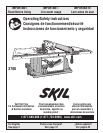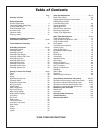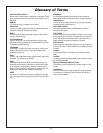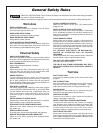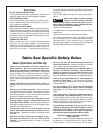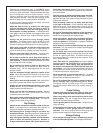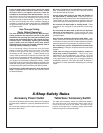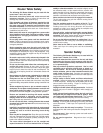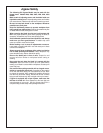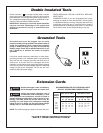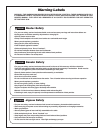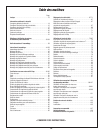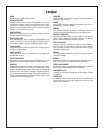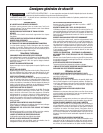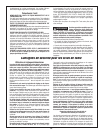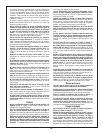
4.
General Safety Rules
“READ ALL INSTRUCTIONS” Failure to follow the safety rules listed below and other basic safety precautions
may result in serious personal injury.
THINK SAFETY Safety is a combination of operator common sense and alertness at all times when the X-Shop is being used.
Work Area
KEEP CHILDREN AWAY
Do not let visitors contact tool or extension cord. All visitors
should be kept away from work area.
KEEP WORK AREAS CLEAN
Cluttered areas and benches invite accidents.
MAKE WORKSHOP CHILD-PROOF
With padlocks, master switches.
AVOID DANGEROUS ENVIRONMENTS
Don’t use power tools in damp or wet locations. Keep work
area well lit. Do not expose power tools to rain. Do not use
tool in presence of flammable liquids or gases.
Personal Safety
KNOW YOUR POWER TOOL
Read and understand the owner’s manual and labels affixed
to the tool. Learn its application and limitations as well as the
specific potential hazards peculiar to this tool.
DON’T OVERREACH
Keep proper footing and balance at all times.
STAY ALERT
Watch what you are doing. Use common sense. Do not op-
erate tool when you are tired. Do not operate while under
medication or while using alcohol or other drug.
DRESS PROPERLY
To avoid being pulled into a blade, do not wear loose
clothing, loose fitting gloves, necktie or jewelry. Tie back long
hair or wear protective hair covering and roll long sleeves
above the elbow. Rubber gloves and non-skid footwear are
recommended when working outdoors.
USE SAFETY GOGGLES
Use safety goggles (head protection). Wear safety goggles
(must comply with ANSI Standard Z87.1) at all times. Wear
non-slip footwear and a hard hat, if appropriate. Also, use
face or dust mask if cutting operation is dusty, and ear
protectors (plugs or muffs) during extended periods of
operation.
GUARD AGAINST ELECTRIC SHOCK
Prevent body contact with grounded surfaces. For example:
pipes, radiators, ranges, refrigerator enclosures.
DISCONNECT TOOL FROM POWER SOURCE
When not in use, before servicing, when changing blades,
bits, cutters, etc.
KEEP GUARDS IN PLACE
In working order, and in proper adjustment and alignment.
REMOVE ADJUSTING KEYS AND WRENCHES
When not in use, before servicing, when changing blades,
bits, cutters, etc.
AVOID ACCIDENTAL STARTING
Make sure the switch is in the “OFF” (“O”) position before
plugging in tool.
NEVER STAND ON TOOL OR ITS STAND
Serious injury could occur if the tool is tipped or if the cutting
tool is accidentally contacted. Do not store materials on or
near the tool such that it is necessary to stand on the tool or
its stand to reach them.
CHECK DAMAGED PARTS
Before further use of the tool, a guard or other part that is
damaged should be carefully checked to ensure that it will
operate properly and perform its intended function. Check for
alignment of moving parts, mounting and any other condi-
tions that may affect its operation. A guard or other part that
is damaged should be properly replaced.
ALL REPAIRS, ELECTRICAL OR MECHANICAL,
SHOULD BE ATTEMPTED ONLY BY TRAINED
REPAIRMEN.
Contact the nearest Skil Factory Service Center, Authorized
Service Station or other competent repair service.
USE ONLY SKIL REPLACEMENT PARTS;
Any others may create a hazard.
THE USE OF ANY OTHER ACCESSORIES NOT SPECI-
FIED IN THE CURRENT SKIL CATALOG MAY CREATE A
HAZARD.
Tool Use
DON’T FORCE TOOL
It will do the job better and safer at the rate for which it was
designed.
USE THE RIGHT TOOL
Don’t force small tool or attachment to do the job of a heavy-
duty tool. Don’t use tool for purpose not intended — for ex
-
ample; don’t use circular saw for cutting tree limbs or logs.
SECURE WORK
Use clamps or a vise to hold work. It’s safer than using your
hand and it frees both hands to operate the tool.
DIRECTION OF FEED
Feed work into a blade or cutter against the direction of
rotation of the blade or cutter only.
NEVER LEAVE TOOL RUNNING UNATTENDED
Turn power off. Don’t leave tool until it comes to a complete
stop.
Be aware of the location and setting of the switch “ON"
position. Never leave the switch in the “ON” position. Be aware
of switch location and know how to shut off the tool in
emergency situations. Accidental start-ups could cause injury.
DON’T ABUSE
THE
CORD
Never use the cord to carry the tools or pull the plug from an
outlet. Keep cord away from heat, oil, sharp edges or moving
parts. Replace damaged cords immediately. Damaged cords
increase the risk of electric shock.
WARNING
!



